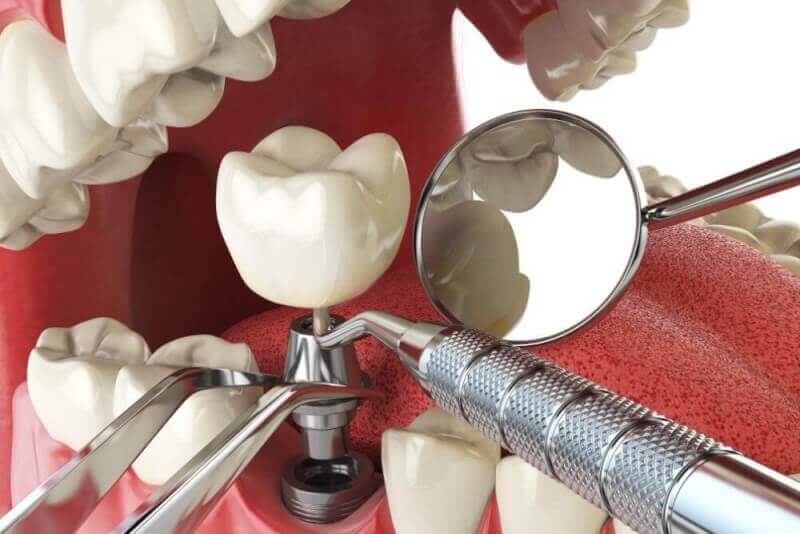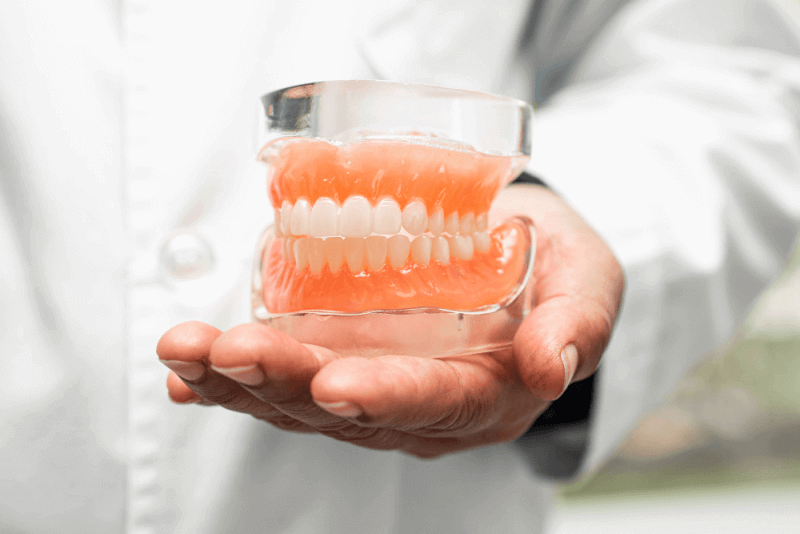What is a Dental Implant?
A dental implant is essentially a material made from various metals that mimics the root of a tooth. Dental implants play a significant role in modern dental treatments, completing the function and aesthetics of missing teeth.
Placing a dental implant within the jawbone helps to preserve the bone tissue. The prosthetics that are later placed on top mimic the teeth, allowing patients to continue their lives comfortably.
When are Dental Implants Necessary?
Dental implants are generally used to replace missing teeth. Specifically, the applications of dental implants include:
- Dental implants are initially used in patients who have no teeth and cannot use removable prosthetics due to jawbone erosion. Implant procedures help preserve the jawbone tissue and create attachment points for prosthetic teeth. This procedure is known as all-on-four.
- Dental implants are also beneficial for the loss of large molar teeth. In the rear of the mouth, these missing teeth can be compensated for with dental prostheses, which provide a much more comfortable use compared to removable prosthetics.
- In cases where there are multiple and consecutive tooth losses, bridges exceed the length of the jaw, and implants are used to solve the resulting problems.
- For single tooth losses, dental implant treatment is applied to avoid damaging the other healthy teeth with crowns.
Types of Dental Implants
In recent years, one of the most frequently chosen treatments in the field of dental health and diseases is the dental implant, which is essentially divided into two types: those classified by structure and those by application method. Each type further divides into subcategories.
Structural Types of Implants
The success of implant treatments depends firstly on the correct placement of the implants. Not only do they fulfill chewing functions seamlessly and comfortably, but they also play a crucial role aesthetically, leading to varied implant types.
Titanium Dental Implants
Titanium is the most successful metal used in dental implants due to its biocompatibility. Modern implants that take on the role of a tooth root and are screw-shaped are made from titanium.
After being placed in the correct position in the jawbone under local anesthesia, titanium dental implants quickly integrate with the bone tissue. This feature allows them to provide an experience and comfort similar to natural tooth roots. They are produced in sizes compatible with patients' jawbones, ensuring a perfect fit in the application area.
Ceramic Dental Implants
Ceramic dental implants are used for patients with metal sensitivities or allergies. They are preferred for their aesthetic qualities as they offer a look closest to natural teeth. Being biocompatible medical materials, ceramics adapt quickly to the body without causing allergic reactions.
Ceramic implants consist of three parts. The first part is implanted into the jawbone. The middle part, known as the abutment, connects to the lower part to facilitate the attachment of the prosthetic tooth. The final pieces of the ceramic implants are the prosthetic teeth themselves.
One-Piece Ceramic Implants
Another type of aesthetically pleasing implant is the one-piece ceramic implant. The main advantage of choosing one-piece ceramic implants is the shorter duration of the treatment compared to other types of implants. Additionally, they provide much better tissue compatibility than titanium implants. Because of these properties, ceramic implants have been increasingly chosen over titanium implants in recent years.
Ceramic-Covered Titanium Implants
In ceramic-covered titanium implants, the part that acts as the tooth root is made of titanium, while the part that functions as the tooth is made of ceramic prosthetics. This combination not only ensures compatibility with the jawbone but also offers a more aesthetic appearance with the ceramic coatings.
The main reasons for choosing titanium-over-ceramic implants include the longevity of titanium and the natural tooth-like appearance provided by the ceramic coatings. Additionally, these implants do not carry an allergy risk and are less conductive of heat, preventing temperature sensitivity in patients.
Types of Implants by Application
Another fundamental type of dental implants is categorized by their method of application. This variety is due to the differences in how the implants interact with the gum tissue and jawbone.
Endodontic Implants
Endodontic implants are used when there is no tooth loss. They are applied within existing teeth to strengthen them and prevent tooth loss. Typically made of ceramic or metal, these implants are placed into the tooth’s root canal. Cylinder, screw, and blade forms of endodontic implants help protect teeth weakened by root canal treatment.
Transosteal Implants
Transosteal implants, which are placed through the entire jawbone, require drilling into the bone to ensure a secure attachment. This feature distinguishes them from other implants and is especially used in patients with insufficient jawbone tissue. Due to its complexity, this procedure can involve general anesthesia and has a longer recovery time.
Intramucosal Implants
Intramucosal implants are applied to the gum tissue in patients with inadequate jawbone or who have lost the tooth root. This type of implant restores the aesthetic appearance of missing teeth and offers advantages such as faster healing and lower risk of infection because it only adheres to the gum tissue.
Subperiosteal Implants
Subperiosteal implants are placed between the jawbone and the gum tissue. This type is typically used in patients with inadequate jawbone and gum recession. While easier to place, subperiosteal implants can cause more tissue damage and are less stable and durable compared to other implant types.
Endosteal Implants
Endosteal implants are another type placed within the jawbone. Available in cylindrical or screw forms, endosteal implants are the most commonly used type for tooth replacement. When used correctly, they are longer-lasting and offer higher durability and stability than other types. The procedure involves creating a hole in the jawbone if the tissue is suitable, and the implant is placed under local anesthesia.
Dental Implant Brands
The success of dental implant treatments and patient satisfaction significantly depend on the brand of implants used. Choosing the right implant from a wide range of products meets all expectations.
Implant brands are imported from various countries, and the most commonly used ones include:
- Megagen ANYRIDGE Implant (South Korea)
- Megagen OCTA Implant (South Korea)
- Straumann ITI Implant (Switzerland)
- Camlog CAMLOG Implant (Germany)
- ZIMMER Implant (USA)
- NEOSS Implant (Switzerland)
- DENTAURUM Implant (Germany)
- BICON Implant (USA)
- THOMMEN Implant (Switzerland)
- OSSTEM Implant (South Korea)
- BIOHORIZONS Implant (USA)
- Biotect KONTACT Implant (France)
- Biotech WEEGO Implant (France)
- Dentsply ASTRA Implant (Switzerland)
- Dentsply XIVE Implant (Germany)
- Dentsply ANKYLOS Implant (Germany)
- Strauman MEDENTIKA Implant (Germany)
- Nobel PARALLEL Implant (Switzerland)
- TEKKA Implant (France)
- Camlog PROGRESSIVA Implant (Germany)
- Mis Implant (Israel)
Dental Implant Complications
Dental implant treatment is highly reliable with a success rate between 90% and 100%. However, some patients may experience issues. The most common complications include:
- Bleeding
- Pain
- Soft tissue injuries
- Damage to adjacent teeth
- Bone damage
- Sinus damage
- Infection
Considerations Before Dental Implant Surgery
Since dental implants serve as tooth roots, the jawbone must be sufficiently robust to anchor the implant before the procedure. If the jawbone is not adequately strong, various orthodontic treatments may be used to enhance the bone structure.
Additionally, the health of the gums must be considered before implantation because it significantly impacts the success of the treatment. Furthermore, the health of the gums must be maintained for the duration of the implant's presence in the mouth.
Lastly, the general health condition of the patients is also crucial for implant treatment. Since it is a surgical procedure, it is vital that patients do not have unmanaged chronic diseases or that these conditions are under control.
How are Dental Implants Placed?
Dental implant treatment is a multi-stage process and thus takes longer to complete compared to other dental treatments. Moreover, it involves surgical intervention.
Stages of Dental Implant Treatment
Dental implant treatment essentially consists of five different stages. These stages can be summarized as follows:
Examination
The first stage of dental implant treatment is the examination. If the patients' general health does not pose any issues for the treatment, a special X-ray is taken to plan the treatment. This X-ray determines the type and length of the implant to be used and the prosthesis to be placed on top of the implant. Therefore, it is crucial to advance the treatment process with specialists in the field.
Surgery
After planning, the second stage involves the surgical placement of the implants. During these procedures, patients are given local anesthesia. The duration of the procedure varies between 30 to 90 minutes depending on the implant being placed. Different techniques are used for placing titanium implants, chosen based on the patient's needs.
Healing
After the implants are placed, a specific period is required for the jawbone to integrate with the implants. This period is six months for implants placed in the upper jaw and three months for those in the lower jaw. Temporary prostheses may be provided to some patients during this stage.
During the healing process, patients can continue their normal diet, provided they do not exert excessive pressure on the implants, and must not neglect regular check-ups.
Placement of the Abutment
Dental prosthetics consist of two parts. The first part acts as the tooth root. The second part, called the abutment, creates the appropriate space for the prosthetic application. This cylindrical piece is placed only after the bone has fully integrated with the implant.
Placement of the Prosthetics
The final stage of dental implant treatment is placing the prosthetics. First, a mold of the upper structure and mouth is taken. Then, prosthetics are made according to this mold using the type of covering chosen by the patients and are applied.
Side Effects of Dental Implant Treatment
Since dental implant treatment involves surgical procedures, it can cause some adverse effects, which include:
- Swelling of the gums
- Minor bleeding
- Swelling of the face
- Bruising on the skin or gums
- Pain in the area where the implant was placed
Diet After Dental Implant Surgery
There are some considerations that patients need to be mindful of in their diet after the surgical implant procedure to ensure a faster and smoother recovery phase.
- Eating foods at room temperature
- Consuming soft foods
- Taking vitamin and mineral supplements as deemed necessary by the dentist
- Avoiding very hard or grainy foods
- Avoiding foods such as fish, chicken, omelets, and pasta for the first two weeks after the procedure
Who Should Not Have Dental Implants?
Dental implants are not recommended for individuals with certain health conditions, including:
- Conditions that would prevent the patient from maintaining dental hygiene after treatment
- Certain heart diseases
- Patients who are not good candidates for surgery (due to extreme anxiety or fear)
- Those with clotting disorders
- Inadequate jawbone structure for implant placement
- Rheumatic diseases
- Uncontrolled diabetes







